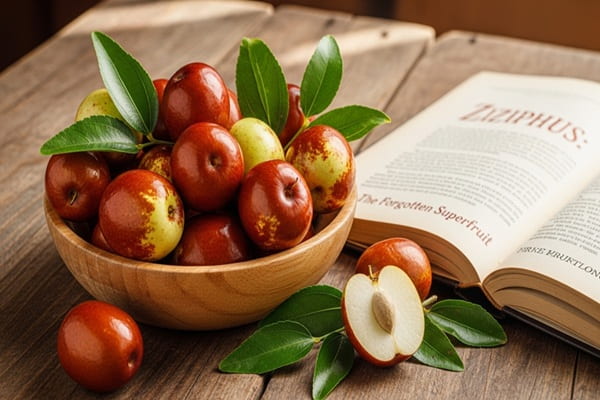Žižole: The Forgotten Superfruit Making a Comeback
Share your love

Have you ever heard of žižole? You might know them by their more familiar names: jujube, Chinese date, or red date. While they’ve been loved in Asia and the Mediterranean for thousands of years, they’re finally getting the global attention they deserve. These little fruits pack a serious punch when it comes to nutrition, wellness, and versatility.
Whether you’re a health nut, herbal remedy enthusiast, or just someone curious about nature’s hidden gems, this guide will walk you through everything you need to know about žižole — from their history and health benefits to how you can enjoy or even grow them at home.
What Exactly Are Žižole?
Žižole come from the Ziziphus jujuba tree, a hardy plant that thrives in warm, dry climates. The tree is part of the buckthorn family and can grow up to 10 meters tall. It sports shiny green leaves, thorny branches, and small, fragrant flowers that bloom in summer. By fall, the tree produces round, olive-sized fruits that start out green and ripen into a rich red-brown.
You can eat them fresh, dried, boiled into tea, or even preserved in syrup. Their flavor is sweet, their texture is pleasantly crisp or chewy (depending on ripeness), and their nutritional value is off the charts.
A Brief History: From Ancient China to Modern Kitchens
Žižole isn’t a trendy new superfruit — it’s a time-tested favorite.
-
Over 4,000 years of cultivation in China.
-
Spread to Korea, India, the Middle East, and eventually Southern Europe and North Africa.
-
In countries like Italy, Slovenia, and Croatia, they’re part of harvest traditions and often used in homemade syrups, teas, and fruit brandies.
-
In Traditional Chinese Medicine (TCM), žižole is revered for calming the mind, nourishing blood, and boosting digestion.
11 Proven Health Benefits of Žižole
Here’s why wellness lovers and nutritionists are excited about this forgotten fruit.
1. Antioxidant-Rich
Žižole contains polyphenols and flavonoids that fight oxidative stress, helping your body age more gracefully and reducing your risk of chronic diseases.
2. Boosts Immunity
Just 100g of fresh žižole gives you 60–80% of your daily Vitamin C, essential for immune health, skin repair, and collagen production.
3. Supports Heart and Blood Health
Žižole are packed with iron, potassium, magnesium, and calcium — key nutrients for circulation, heart rhythm, and nerve function.
4. Naturally Calming
Feeling anxious or struggling with sleep? Compounds like jujuboside A act as a gentle, natural sedative that may improve rest and reduce anxiety.
5. Improves Digestion
Their high fiber content and digestive enzymes support gut health, ease bloating, and promote regular bowel movements.
6. Anti-Inflammatory Effects
Studies show that žižole contains compounds that can reduce inflammation and help fight bacteria and viruses.
7. Supports Brain Function
The antioxidants in žižole also help protect your brain, potentially improving memory, focus, and reducing mental fatigue.
8. Skin Rejuvenation
Thanks to its rich Vitamin C content and detoxifying effects, žižole may support clearer skin and fight signs of aging.
9. Stabilizes Blood Sugar
With a low glycemic index (25–30), žižole is a good snack option for those watching their blood sugar levels.
10. Aids in Menstrual Health
In TCM, žižole is often used to support women’s health, especially for reducing menstrual cramps and regulating cycles.
11. Energizing Without the Crash
Forget caffeine — žižole offers natural energy without jitters, making it a great midday pick-me-up.
Nutrition Snapshot (Per 100g – Fresh)
| Nutrient | Amount |
|---|---|
| Calories | 79 kcal |
| Carbohydrates | 20 g |
| Dietary Fiber | 2.6 g |
| Vitamin C | 69 mg |
| Potassium | 250 mg |
| Iron | 0.5 mg |
| Protein | 1 g |
| Fat | 0.2 g |
How to Eat Žižole: Delicious Ways to Enjoy Them
Žižole are as versatile as they are nutritious. Here’s how to enjoy them in your meals:
Fresh
Crisp and slightly tart, fresh žižole can be eaten like an apple. Slice them into salads or mix them with nuts for a healthy snack.
Dried
Once dried, they taste like dates and are perfect for:
-
Trail mixes
-
Baking into muffins or bread
-
Topping cereal or yogurt
-
Brewing into herbal teas
Tea
Boil dried žižole with ginger and cinnamon for a traditional Asian remedy known to aid sleep and relieve stress.
Syrups and Jams
Boil them with sugar and lemon for a soothing syrup — perfect in winter or drizzled over toast and pancakes.
Liqueurs
In parts of the Balkans, people soak žižole in homemade brandy or rakija for a festive herbal infusion.
Also Read : The Rising Popularity of the Swimsuit Edition [ABBB] – 1.20 21 Swimsuit Edition – Chapter
Where to Buy Žižole
Žižole isn’t yet a mainstream fruit, but you can still find them in the right places:
-
Asia & Europe: Local farmers markets in China, Croatia, Italy, Turkey, and India.
-
North America: Look in Asian grocery stores, especially Chinese or Korean markets.
-
Online: Herbal retailers like Mountain Rose Herbs, iHerb, or Etsy often carry dried žižole.
Want to Grow Your Own? Here’s How
The žižole tree is surprisingly low-maintenance and perfect for home gardens.
Ideal Growing Conditions
-
Soil: Sandy or loamy soil that drains well.
-
Sunlight: Full sun (at least 6 hours a day).
-
Climate: USDA zones 6–10; needs cold winters for fruiting.
Planting Tips
-
Plant in spring from bare-root or grafted trees.
-
Space trees 10 to 15 feet apart.
-
Prune in winter to shape.
-
Fertilize in spring with compost or low-nitrogen mix.
Harvesting
-
Fruit ripens from late summer to early fall.
-
Pick when red-brown and slightly soft.
-
Eat fresh or dry for long-term storage.
Žižole vs. Dates: What’s the Difference?
Many confuse žižole with traditional dates, but they’re not the same.
| Feature | Žižole (Jujube) | Dates (Phoenix dactylifera) |
|---|---|---|
| Origin | China | Middle East / North Africa |
| Texture | Crisp or chewy | Always soft and sticky |
| Calories (per 100g) | ~79 kcal | ~277 kcal |
| Sugar Content | Lower | Higher |
| Vitamin C | High | Low |
| Glycemic Index | Lower (25–30) | Higher (42–55) |
A Traditional Medicine Staple
In traditional herbal systems, žižole is used to:
-
Promote restful sleep
-
Ease menstrual symptoms
-
Improve digestion and appetite
-
Strengthen immunity
-
Calm emotional stress and anxiety
Final Thoughts: Why You Should Give Žižole a Try
Žižole might be small, but they deliver big when it comes to nutrition, healing properties, and culinary flexibility. With the world shifting toward plant-based wellness and natural superfoods, these ancient fruits are making a well-deserved comeback.
Whether you’re sipping on jujube tea before bed, tossing fresh ones into a salad, or growing your own in the backyard — adding žižole to your life is a simple, delicious step toward better health.






